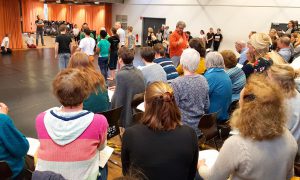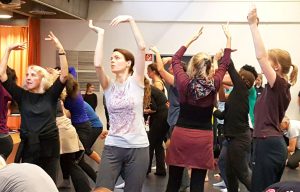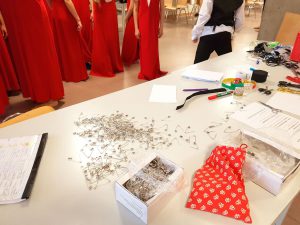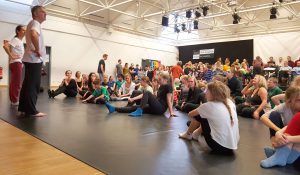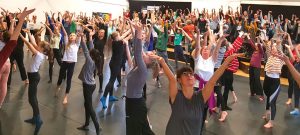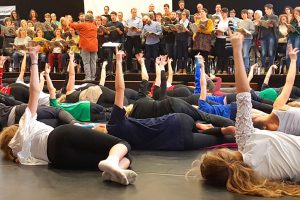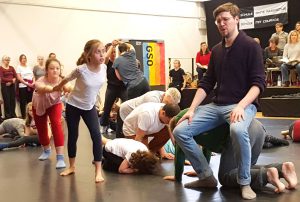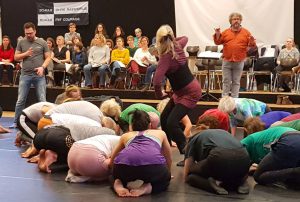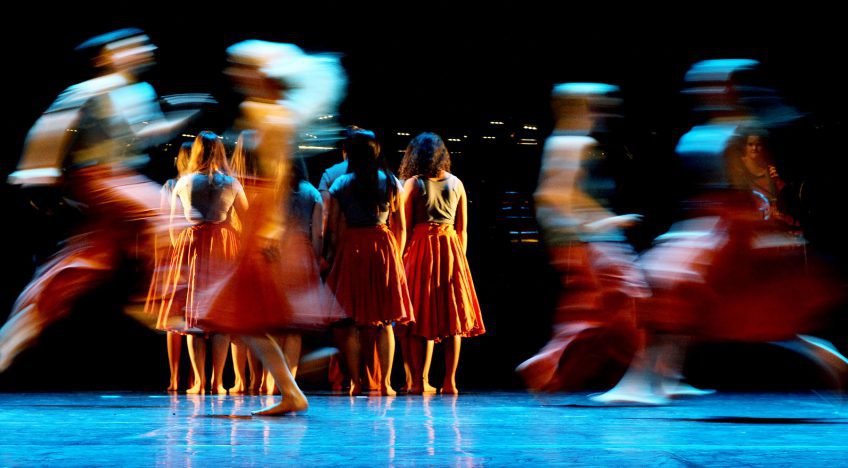
Foto: Claudia Hoppens, DE LooPERS
The idea of community dancing was born in the late seventies in the UK. At the beginning, community dance was defined by the type of audience. In addition, the charitable nature of the projects, which often targeted marginalized communities in rural areas or in the social hotspots of cities, was another feature of community dance. Over time, the composition of groups has become increasingly flexible: there are now projects for difficult young people, single mothers, the blind, etc. and more often for all these groups at the same time. Increasingly, professional dancers and amateurs are also on stage together. Generation or so-called cross-generation projects are currently in vogue.
Community dance or dance for all “it’s about giving a community or a socially or culturally defined group access to dance. Integration can, but does not necessarily have to be an issue. When several groups work together, the participants discover that they are part of a larger community that offers something new and surprising, “and that may make them see their own position in society with new eyes. Prejudices disappear by themselves when everyone is dancing, and everyone can get confirmation.
Community dance events can and should, but do not necessarily have to be a performance. An important aspect of this is that the audience “parents, siblings, friends and relatives, etc.” often comes into contact with dance for the first time. This will gradually lead to a wider audience for professional dance (-> dance education, cultural engagement).
It is one of the basic principles of community dance that invariably everyone can participate and get involved. So each participant has to be given the opportunity to look good on stage. In general, the contemporary dance is best for community dance projects as they offer every individual and every individual the opportunity to emotional expression and adaptation to the group, and even demand from them, ultimately causing more people to be involved and physically impaired people.
Community Dance is defined by each project manager and each project manager in a new and different way and characterized by personality, initiative and passion.
(aus: Royston Maldoom. Community Dance. Jeder kann tanzen. Das Praxisbuch von Jacalyn Carley, Henschel Verlag, Leipzig, 2010)
Royston Maldoom made known in the early 2000s with his dance4life project Community Dance worldwide. In each of 25 countries around the world, 100 disadvantaged youths living in difficult social circumstances danced around the world simultaneously choreographing the same music. This project was also intended as a contribution to education about HIV infections and prevention. The acclaimed and award-winning film “Rhythm is it” was created in 2004 through this project.
Wilfried van Poppel was the first to bring the dance4life project to Germany and it developed into a still lasting friendship between Wilfried and Royston. After this collaboration Wilfried decided to continue to work with children and young people in the field of community dance.
Meanwhile, DE LooPERS-dance2gether have been organizing community dance projects with children and young people for over 10 years. Every year since 2009, major dance theater projects with children have been performed in Bremen always endeing in a public performance, accompanied by choir or orchestra. To emphasize is the special character of these dance theater productions, which brings together children and young people from all social classes and with the most diverse skills and experiences. DE LooPERS dance theater projects are always inclusive and integrative and allowing everyone an active participation in an artistic process.
Several thousands of children and adolescents have participated in Amaya Lubeigt and Wilfried van Poppel’s “Five days to dance” workshops in schools in Bremen, Germany and throughout Europe. In 2013/14, the award-winning documentary “Five days to dance” (ES 2014, R. Moles / P.Andreu) was coming up and is showing this work.
From 2015 to 2017, young people from Bremen, dancers from Spain, Scotland and the Netherlands, participated in the “Creative Europe” EU cooperation project “Let’s Dance! Europe”, with artistic direction of Wilfried van Poppel.
In 2016 DE LooPERS-dance2gether was cultural partner of the European Capital of Culture, San Sebastian and responsible for the community dance program.
Most recently, DE LooPERS-dance2gether was honored in August 2017 with the prize “Förderpreis Kulturnachwuchs” launched by the swb education initiative and the Senator for Culture, Bremen.
On 2nd and 3rd of February 2019, the anniversary event of DE LooPERS-dance2gether was performed in the Theater Bremen. The Wheel of Fortune-Carmina Burana was the theme of the joint production with IntoNation, the choir of the Hochschule Bremen, and the ThinkMusic! Children’s choir of the Gerhard-Rohlfs-Schule from Bremen-Nord.
More Information:
www.de-loopers.eu
www.facebook.com/deloopers.dance2gether/
Pictures from rehearsals of Wheel of fortune-Carmina Burana, All Fotos: Frank Borowski
